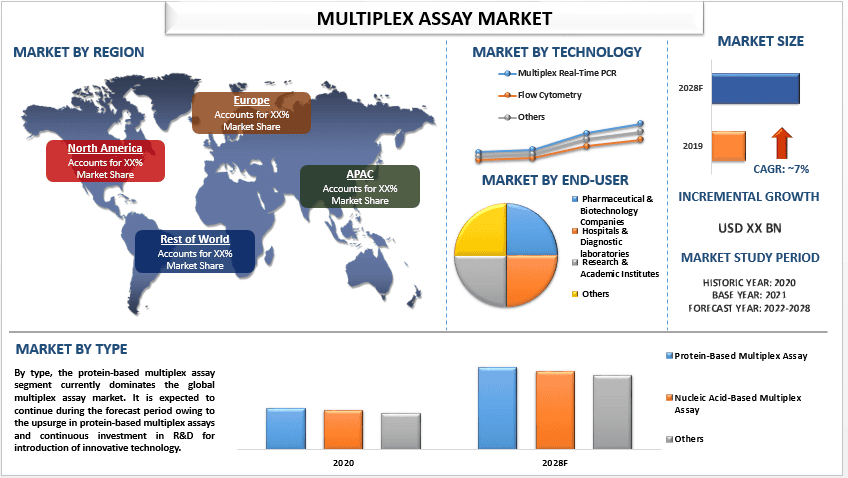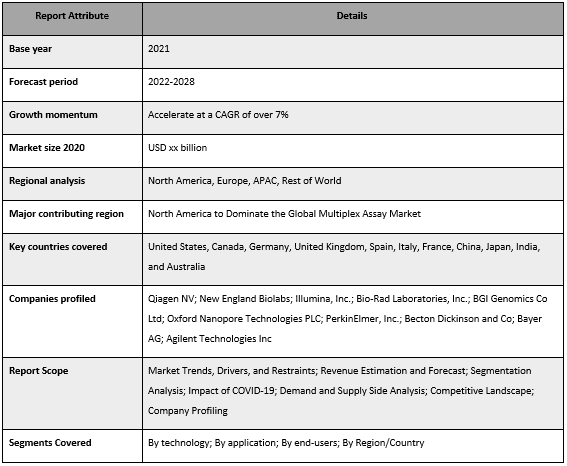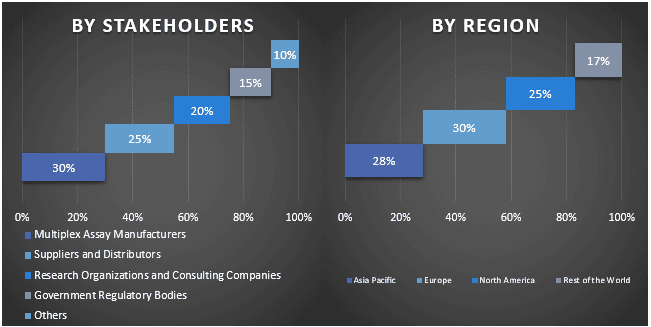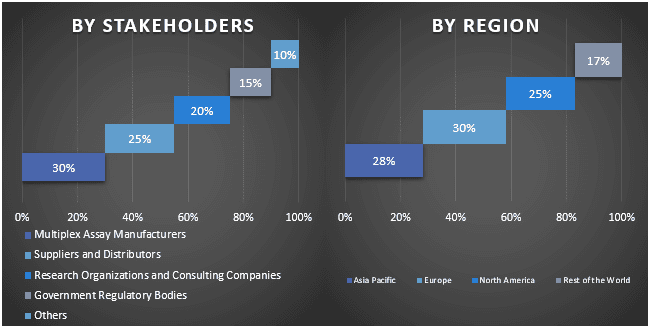Emphasis on Product (Reagents & Consumables, Instruments & Accessories, and Software & Services); Type (Protein-Based Multiplex Assay, Nucleic Acid-Based Multiplex Assay, and Others); Technology (Multiplex Real-Time PCR, Flow Cytometry, and Others); Application (Clinical Diagnostics and Research & Development); End-User (Pharmaceutical & Biotechnology Companies, Hospitals & Diagnostic laboratories, Research & Academic Institutes, and Others); and Region/Country

The Multiplex Assay market is expected to register a CAGR of approx. 7% over the period of 2022-2028. There are different types of multiplex assays, but the basic principle involves labeling each analyte with a specific probe (such as a fluorescent tag or an antibody), which is then detected and quantified using specialized instruments. The probes can be designed to bind specifically to the target analytes, allowing for highly specific and sensitive detection. Multiplex assays can be used in a variety of applications, including disease diagnosis, drug discovery, and biomarker identification. They offer several advantages over traditional single-analyte assays, including faster turnaround time, reduced sample volume requirements, and increased efficiency. Overall, multiplex assays provide a powerful tool for researchers to gain deeper insights into complex biological processes and to develop more effective diagnostic and therapeutic strategies. In addition, the introduction of novel and advanced products and the growing acceptance of these assays are likely to aid market growth.
Luminex Corporation, Thermo Fisher Scientific Inc., Bio-Rad Laboratories, Inc., QIAGEN N.V., Becton, Dickinson and Company, Merck KGaA, Seegene Inc., Perkin Elmer Inc., Abcam PLC, Agilent Technologies Inc. are some of the key players in the market. Several M&As along with partnerships have been undertaken by these players to facilitate customers with hi-tech and innovative products/technologies.
Insights Presented in the Report
“Amongst technology, the multiplex real-time PCR category accounted for the significant share in the market in 2020”
Based on the technology, the multiplex assay market is segmented into multiplex real-time PCR, flow cytometry, and others. The multiplex real-time PCR segment accounted for a significant market share, and it is estimated that it will grow rapidly during the projected timeframe. PCR technology is widely used in a variety of end-use applications. Furthermore, the widespread use of PCR technologies for COVID-19 detection has resulted in significant revenue generation by this technology.
Multiplex Assay Market Report Coverage

“Amongst application, the research & development category grabbed a considerable market share during the forecast period”
Based on the application, the market is fragmented into clinical diagnostics and research & development. The research & development segment grabbed a considerable market share during the forecast period. Multiplex assays are becoming more and more used in the drug discovery process. These tests are employed in preclinical and clinical phases to assess drug response biomarkers, immunotherapy efficacy, and toxicity.
“North America to witness significant growth during the forecast period”
For a better understanding of the market adoption of Multiplex Assay, the market is analyzed based on its worldwide presence in the countries such as North America (U.S., Canada, and Rest of North America), Europe (Germany, France, Italy, Spain, U.K., and Rest of Europe), Asia-Pacific (China, Japan, India, Australia, and Rest of APAC), and Rest of World. North America constitutes a major market for the multiplex assay industry owing to the presence of various research programs in the region, as well as the expansion of R&D efforts for the creation of new medications and diagnostic and therapeutic approaches. The rise in government financing for the discovery of new biomarkers and the increased frequency of chronic diseases like cancer and stroke are expected to fuel the region’s growth. Furthermore, the rise is probably going to be fueled by the presence of important players in the area.
Reasons to buy this report:
Customization Options:
Global multiplex assay market can further be customized as per the requirement or any other market segment. Besides this, UMI understands that you may have your own business needs, hence feel free to connect with us to get a report that completely suits your requirements.
1. Market Introduction
2. Research Methodology Or Assumption
3. Market Synopsis
4. Executive Summary
5. Impact Of Covid-19 On The Multiplex Assay Market
6. Multiplex Assay Market Revenue, 2020-2028f
7. Market Insights By Product
8. Market Insights By Type
9. Market Insights By Technology
10. Market Insights By Application
11. Market Insights By End-user
12. Market Insights By Region
13. Multiplex Assay Market Dynamics
14. Multiplex Assay Market Opportunities
15. Multiplex Assay Market Trends
16. Demand And Supply Side Analysis
17. Value Chain Analysis
18. Strategic Insights
19. Competitive Scenario
20. Company Profiled
21. Disclaimer
Research Methodology for the Global Multiplex Assay Market Analysis (2022-2028)
Analyzing the historical market, estimation of the current market, and forecasting the future market of the global multiplex assay market were the three major steps undertaken to create and analyze the adoption of multiplex assay in major regions globally. Exhaustive secondary research was conducted to collect the historical market numbers and estimate the current market size. Secondly, to validate these insights, numerous findings and assumptions were taken into consideration. Moreover, exhaustive primary interviews were also conducted, with industry experts across the value chain of the global multiplex assay market. Post assumption and validation of market numbers through primary interviews, we employed a top-down/bottom-up approach to forecasting the complete market size. Thereafter, market breakdown and data triangulation methods were adopted to estimate and analyze the market size of segments and sub-segments the industry pertains to. Detailed methodology is explained below:
Analysis of Historical Market Size
Step 1: In-Depth Study of Secondary Sources:
Detail secondary study was conducted to obtain the historical market size of the multiplex assay market through company internal sources such as annual report & financial statements, performance presentations, press releases, etc., and external sources including journals, news & articles, government publications, competitor publications, sector reports, third-party database, and other credible publications.
Step 2: Market Segmentation:
After obtaining the historical market size of the multiplex assay market, we conducted a detailed secondary analysis to gather historical market insights and share for different segments & sub-segments for major regions. Major segments included in the report as the product, type, technology, application, and end-user. Further country-level analyses were conducted to evaluate the overall adoption of testing models in that region.
Step 3: Factor Analysis:
After acquiring the historical market size of different segments and sub-segments, we conducted a detailed factor analysis to estimate the current market size of the multiplex assay market. Further, we conducted factor analysis using dependent and independent variables such as an expanding need for research and development in the fields of molecular diagnostics, companion diagnostics, etc. globally. A thorough analysis was conducted for demand and supply-side scenarios considering top partnerships, mergers and acquisitions, business expansion, and product launches in the multiplex assay market sector across the globe.
Current Market Size Estimate & Forecast
Current Market Sizing: Based on actionable insights from the above 3 steps, we arrived at the current market size, key players in the global multiplex assay market, and market shares of the segments. All the required percentage shares split, and market breakdowns were determined using the above-mentioned secondary approach and were verified through primary interviews.
Estimation & Forecasting: For market estimation and forecast, weights were assigned to different factors including drivers & trends, restraints, and opportunities available for the stakeholders. After analyzing these factors, relevant forecasting techniques i.e., top-down/bottom-up approach was applied to arrive at the market forecast about 2028 for different segments and sub-segments across the major markets globally. The research methodology adopted to estimate the market size encompasses:
Market Size and Share Validation
Primary Research: In-depth interviews were conducted with the Key Opinion Leaders (KOLs) including Top Level Executives (CXO/VPs, Sales Head, Marketing Head, Operational Head, and Regional Head, Country Head, etc.) across major regions. Primary research findings were then summarized, and statistical analysis was performed to prove the stated hypothesis. Inputs from primary research were consolidated with secondary findings, hence turning information into actionable insights.
Split of Primary Participants in Different Regions

Market Engineering
Data triangulation technique was employed to complete the overall market estimation and to arrive at precise statistical numbers for each segment and sub-segment of the global multiplex assay market. Data was split into several segments & sub-segments post studying various parameters and trends in the areas of product, type, technology, application, and end-user in the global multiplex assay market.
The Main Objective of the Global Multiplex Assay Market Study
The current & future market trends of the global multiplex assay market were pinpointed in the study. Investors can gain strategic insights to base their discretion for investments on the qualitative and quantitative analysis performed in the study. Current and future market trends determined the overall attractiveness of the market at a regional level, providing a platform for the industrial participant to exploit the untapped market to benefit from a first-mover advantage. Other quantitative goals of the studies include:

Customers who bought this item also bought